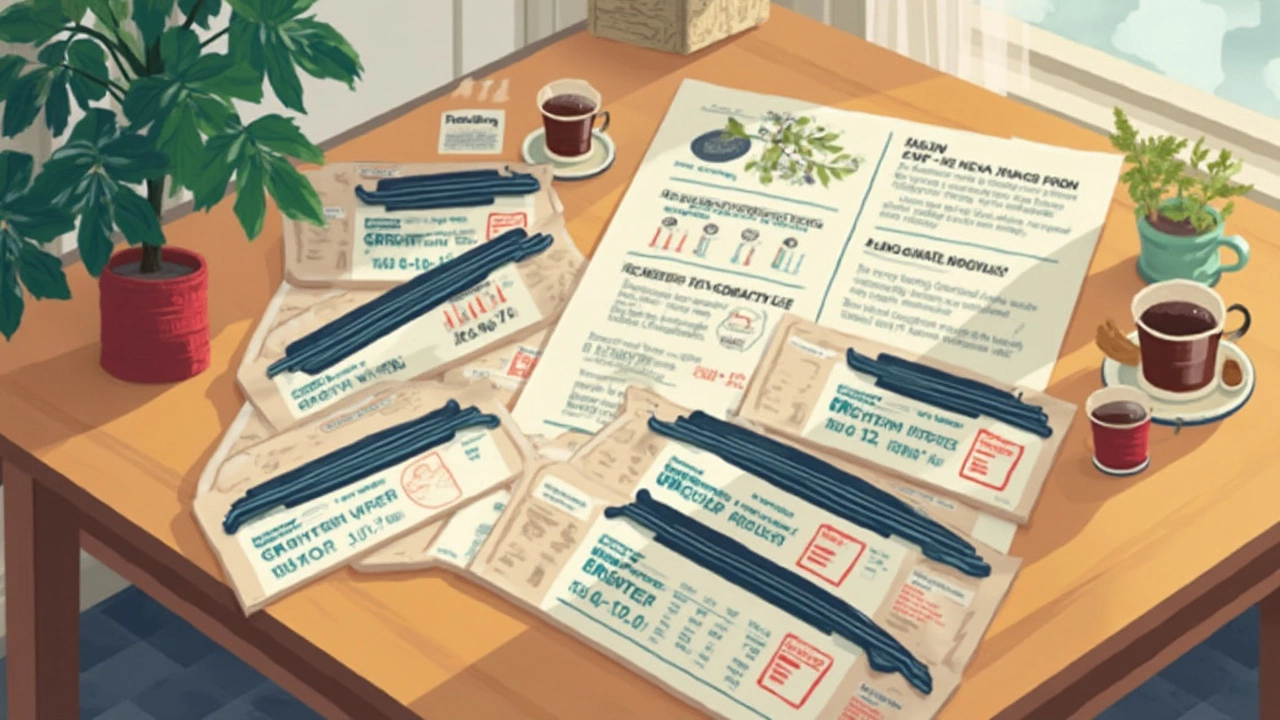Surprised at how much you just paid for new wiper blades? You’re not alone. Walk into any auto parts store, and the price tags jump all over the place—sometimes even over $40 for a single pair. Are you actually getting more for your money, or just paying extra for packaging and a fancy brand name?
Here’s the deal: for most everyday cars, a good set of standard windshield wipers usually runs between $15 and $25 for a pair. The price can go way up if you drive something quirky or buy into the “premium” lines. Some dealership parts counters will quote you $60 or more for a set, which is wild when you realize most blades are made in a handful of the same overseas factories anyway.
Understanding what affects the price helps you dodge unnecessary markups. Don't get tricked by shiny displays or technical jargon. Look at the fit for your car, what kind of climate you live in, and what materials the blades use. Sometimes $10 blades do just as well as ones that cost three times more—especially if you swap them out when they start streaking or squeaking.
- How Much Do Windshield Wipers Really Cost?
- What Factors Affect Wiper Prices?
- Are Expensive Wipers Worth It?
- Buying Tips: Saving Money Without Sacrificing Quality
- Replacing Blades: When and Where to Get the Best Deal
How Much Do Windshield Wipers Really Cost?
If you’re just after solid blades to keep your view clear, you don’t need to shell out a week’s grocery money. The typical price for a pair of standard windshield wipers is between $15 and $25 at most big-box stores or online. Some ultra-basic blades dip as low as $10 for a set, while names like Bosch or Rain-X often land closer to the $20-$30 range for the pair.
There’s a wild spread in price depending on where you shop and what you pick. Dealerships can charge $50 or more for factory-branded blades, which are sometimes identical to $15 store brands. If your car takes a specialty length or a rare attachment style, you might see prices creep higher, especially for imports or luxury vehicles.
A look at 2025 prices shows this:
| Type | Low-End Pair | Average Pair | Premium Pair |
|---|---|---|---|
| Standard Rubber | $10 | $18 | $30 |
| Beam/Bracketless | $18 | $28 | $45 |
| Hybrid | $20 | $32 | $50 |
| Dealer/Factory OEM | — | $35 | $65+ |
Big savings tip: auto parts stores and places like Walmart usually have decent sales or bundled discounts, dropping the per-pair cost even more. Don’t be shocked if the exact same wiper is $12 in one shop and $28 at the gas station down the street.
The windshield wiper price is about more than just the sticker. Some stores charge for installation, usually $5-$10 extra. Of course, swapping blades is an easy DIY job for most cars. You can look up a YouTube video and be done in five minutes—no tools needed, no special skills required.
If you haven’t replaced yours in a year (or if they’re streaking, dragging, or chattering), it’s time. Paying $15 for new ones is way easier than risking poor visibility in a sudden downpour.
What Factors Affect Wiper Prices?
Ever wonder why windshield wiper price tags are all over the map? It’s not just random. There are a bunch of reasons prices jump around, and some of them actually make sense. Others? Not so much. Let’s get clear on what really drives the cost so you don’t feel like you’re throwing money out the window.
Here’s what’s going on behind the scenes when you spot those price differences:
- Type of wiper blade: You’ll usually see two main types—traditional frame-style and beam blades. Beam blades are sleeker and better in snow or ice, but they also tend to cost more. Specialty blades like hybrid styles land somewhere in between.
- Brand: Big names like Bosch, Rain-X, or Michelin typically charge more. Store brands or less popular names are often cheaper and can work just as well for everyday needs.
- Size and fit: The longer or less-common your wiper size is, the pricier it’ll get. Some newer cars need a very specific blade shape or attachment, which bumps up the cost.
- Materials: Basic blades use standard rubber. Premium ones are coated with stuff like silicone, Teflon, or graphite for quieter, longer life—but the price jumps with these upgrades.
- Where you buy: Retail chains and car dealerships usually mark up way more than online retailers or local auto parts stores. If you buy during winter or rainy season, you’ll likely pay more, too.
To give a clearer picture, here’s a quick breakdown of average 2024 prices for different blade types in the U.S. (just to show how much these factors matter):
| Type | Average Price Each (USD) | Typical Lifespan (Months) |
|---|---|---|
| Standard Frame | $7–$15 | 6–9 |
| Beam Blade | $12–$25 | 9–12 |
| Hybrid Blade | $10–$20 | 9–12 |
| Dealer/OEM | $20–$35 | 12 |
So, when you’re standing in front of a wall of wipers, keep your wits. Figure out your car’s needs and don’t let marketing talk you into paying for features you’ll never notice. Basic blades often do the job just fine—especially if you’re on top of swapping them out before they wear down.

Are Expensive Wipers Worth It?
You’ve probably seen those $40 wiper blades in slick packaging, promising months of clear vision and special coatings that beat back any rainstorm. But do they really live up to the hype?
First off, expensive wipers often mean “beam” or “hybrid” style blades. These usually fit a little better on curved windshields and can handle tougher weather, especially if you live somewhere with endless rain or winter slush. But here’s the kicker—Consumer Reports and several car magazines have tested premium blades like Rain-X Latitude, Bosch ICON, or Michelin Stealth against lower-priced but reputable brands like Anco or Trico. The difference in wiping performance is surprisingly small for everyday driving, especially if you replace your blades a couple times a year.
- Premium blades might last a few extra months in harsh weather, but for most people who drive in average conditions, that small boost in lifespan just doesn’t match the bump in price.
- Some pricier blades come with fancy features, like silicone edges or hydrophobic coatings. Those coatings can help water bead off your windshield, but you can get that same effect with a $7 bottle of Rain-X rather than a $40 wiper replacement.
- OEM (dealer) blades for certain cars—think European or luxury models—can be double or triple the price of good aftermarket options, but they’re not always better. You’re mostly paying extra for branding and packaging.
The most important thing is regular replacement. Even the most expensive windshield wiper price won’t matter if the blade has dried out or cracked from sitting in the summer sun. Don’t get wowed by marketing—choose something that fits your car and budget, and swap them out when they start to streak or chatter. That’s smarter than overspending on luxury wipers every time.
Buying Tips: Saving Money Without Sacrificing Quality
Let’s not pretend wipers are flashy, but they aren’t something to cheap out on either. The right buying method can save you real money without leaving you squinting through streaks every time it rains.
First, don't assume dealer prices mean better quality—you’re just paying their markup. A dependable set from a big-box retailer or a locally owned auto store often matches or beats what the dealership sells, especially if you check brands like Rain-X, Bosch, or Michelin. Most of those brands' mid-range lines perform just as well in real-world road tests as their pricier "premium" siblings.
- Check your car’s manual or measure your old blades. Sizing is everything—a blade too long or too short won’t clean right.
- Online shopping is your friend. Amazon, Walmart, and RockAuto show you multiple brands, real reviews, and let you filter by your car model so you don’t guess the wrong fit.
- Avoid bundles with fancy washer fluid or add-ons unless it’s a genuine discount. Sometimes, websites hype up “kits” that cost more for no real benefit.
- If you see BOGO (buy-one-get-one) or rebates, those are often legit, especially from trusted brands. These deals can cut the cost per set way down.
- Basic “bracket” blades (those old-school metal ones) are usually the cheapest—sometimes even $8 each—but they don’t last as long as beam-style blades, which cost a few bucks more but work better in rain, snow, and tough weather.
A lot of people don’t know this: Consumer Reports’ 2024 update showed several sub-$20 blades from brands like Anco and Trico matching the longevity and performance of models selling for $35 or more. Here’s a quick look at average prices by type:
| Wiper Type | Average Price (Pair) | Best Use |
|---|---|---|
| Bracket (Frame) | $14–$20 | Basic, older cars, warm climates |
| Beam (Flat) | $18–$30 | All seasons, better in snow/ice |
| Hybrid | $22–$36 | All-around, tough weather, newer cars |
Stick to the middle of the road—don’t grab the cheapest off-brand, but you can skip the ones packaged like gold bars. And one more tip: never pay for "professional installation" unless it’s bundled for free. Most wipers snap on in under a minute. If you get stuck, search up a two-minute YouTube video using your car’s year and model. You’ll save the ten bucks installation fee and probably feel a little smug after.
So, hunt for deals, use real-world reviews, and remember that the best windshield wiper price isn’t always the one that catches your eye first—it’s the one that keeps your vision clear without draining your wallet.

Replacing Blades: When and Where to Get the Best Deal
Most people forget about their wiper blades until the rain hits and they get nothing but streaks. That’s when you realize it’s time for new blades. A good rule is to check windshield wiper price and blade condition every 6-12 months. In hot places like Arizona or Florida, rubber breaks down faster. In snowy climates, the salt eats at the material too. If you see cracks, bends, or they start squeaking, it’s game over—swap them out.
So, when’s the best time to buy wipers? Look for deals at the start of rainy or winter seasons. Loads of stores, from big box retailers to online sites, run promos around October and April. If you’re sticking to basics, a lot of people swear by brands like Rain-X or Bosch, which pop up on sale for under $20 a pair pretty often.
Where can you get the most bang for your buck? Here’s how shops and prices stack up:
| Retailer | Average Pair Price | Perks |
|---|---|---|
| AutoZone/O'Reilly | $15-$30 | They'll often install for free |
| Amazon | $11-$22 | Big selection, fast shipping |
| Walmart | $10-$18 | Low prices, easy returns |
| Dealership | $35-$60 | Exact match, pricey |
Avoid the car dealership unless your car is super picky about its parts (think luxury brands or odd sizes). For 95% of drivers, you’re fine grabbing a set from auto parts stores or even Costco when they run two-for-one deals. Some shops will even put them on for you, which is handy if you’re not into DIY stuff.
If you want to save the most, grab a spare set when you spot a sale and stash them in your trunk. This is a favorite hack in our family. Hannah loves having extras on hand so we’re not caught out in a storm. Also, don’t be tempted by multi-packs at gas stations — they’re usually marked up and not great quality.
